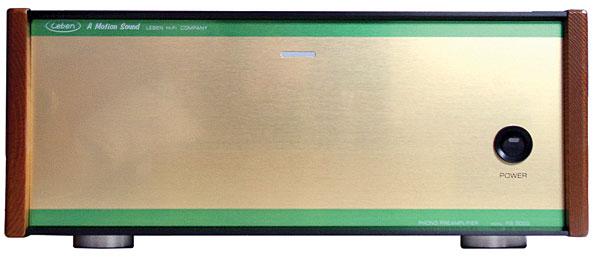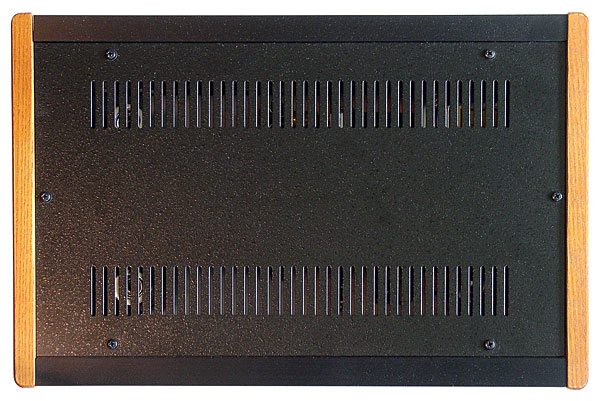Leben CS300x Integrated Amplifier & RS30EQ Phono Stage
R62,000.00
Client UPGRADED and this magnificent pair becomes available!
NOTE: Price included BOTH units… the integrated CS300x ($3295) and the RS30EQ Phonostage ($2695)

The Leben RS-30EQ phono preamplifier ($2695) incorporates a pair of common dual-triode tubes (12AT7) for phono gain, but breaks with tradition by using a CR-type equalization circuit rather than the more common negative-feedback type. Total gain is specified as 23.5dB, which is sufficient for moving-magnet pickups; an external transformer is recommended for use with moving-coil types. A silicon full-wave rectifier supplies heater voltage, while the rail is supplied by a 6X5GT rectifier tube.The RS-30EQ is just as well built as Leben’s CS300 integrated amplifier, with which I auditioned it, some of its parts being even more robust. A few of the RS-30EQ’s power-supply components are assembled on a small fiber-composite board—not a printed-circuit board—with most other parts supported by terminal strips. As with the CS300, everything was neatly wired, point-to-point. Unsurprisingly for a phono preamp—especially one that uses CR equalization—there were signs of extra shielding inside the RS-30EQ, and Leben says that a specially made “orient-core” power transformer was chosen for this product in an effort to minimize hum and noise.
Sound Quality
Because the Leben integrated amp lacks a phono stage, I supplemented the CS300 with the RS-30EQ, using a 1.5m-long Audio Note AN-Vx interconnect to go from the outputs of the latter to the inputs of the former. I preceded the Leben phono preamp with either an Auditorium 23 SPU Standard or Silvercore One-to-Ten step-up transformer, for use with low- and high-output MC pickups, respectively. The two Leben components sat directly on the wood shelves of my borrowed Box Furniture rack; only stock AC cords were used.
From the start, the Leben combination distinguished itself as a punchy and realistically textured amp with an especially deep, tight bottom end. Most stereo recordings sounded pleasantly large through the Leben, with instruments and voices maintaining good physical presence. The Leben was tonally well balanced overall, and although it had the sort of warmth and humanness I associate with tube amplification in general, it was free from egregious timbral colorations.
Rachmaninoff’s Vocalise, Op.34, from Analogue Productions’ recent 45rpm remastering of the recording by Donald Johanos and the Dallas Symphony Orchestra (Vox Turnabout TV 34145S), sounded lovely through the Leben, with sweet, delicate string tone and perfectly colorful woodwinds. Internote silences were reasonably “black,” though not nearly as stygian as with the best Shindo and Lamm electronics of my acquaintance. String tone, especially in the double basses, was also fine while playing through the Leben electronics a 1960 recording of Saint-Saëns’s Carnival of the Animals, with Beatrice Lillie, Skitch Henderson, and the London Symphony Orchestra (LP, Decca SXL 2218). The performance was sufficiently present that my dog expressed a keen interest in the various animal sounds therein (recorded for the occasion at the London Zoo).

The Leben didn’t have all the color and physicality of the Shindo separates when playing the curiously titled “Old Danger Field,” from Bill Monroe’s 1981 studio album Master of Bluegrass (LP, MCA 5214), but it was on the same page: enough to make the listening experience enjoyable as more than just hi-fi, if you know what I mean. Monroe’s mandolin didn’t leap from the mix, and the imaginary stage was spatially a bit flat overall—but it was rather wide and tall in comparison to that of the other amps, with a convincing sense of scale. Bass impact was excellent, as was the timing of the notes played by the upright bass. In the midrange and trebles, things clucked that ought to have clucked.
Conclusions
A quick tour through audio’s alternative fora uncovers a generous amount of praise for the Leben CS300—to which I can only add my admiration: This exceptionally well-made amp and its companion phono preamp sounded wonderful in my home. They were a pleasure to look at, a pleasure to use, and delightful to hear.
Combined, the retail price of my Shindo separates is approximately $27,500. For less than a quarter of that amount, Leben CS300 integrated and RS-30EQ phono preamp provided a lot more than a quarter of their musical and sonic abilities. They didn’t have all of the Shindos’ color, presence, internote silence, or magical sense of flow, but the Lebens had their wheels firmly planted on the same road.
| When I compared the CS-300X to my Manley Labs Stingray, I was surprised how alike they were sonically. They both have the same open, airy sparkle in the highs, punchy fluid bass and smooth midrange. I suspect these are traits of the EL84 pentode as the two or three other EL84 amps I have heard also sounded similar. The Leben was perhaps a little softer and less dynamic. The Stingray with its octet of EL84s and resultant higher power output exhibited greater weight and slam and was thus more suited to higher listening levels. Rhythm and propulsion are indeed the Stingray’s forte yet the little Leben was not too far behind. On the other hand, the Leben had a lovely intoxicating, golden sweetness allied to a slightly greater delineation of detail. The Leben simply offered a more delicate and nuanced presentation. Subtle musical details were more apparent.
|
||||||||||||
 |
||||||||||||
| I thought the stock NOS Mullard tubes might be partially responsible so I swapped them out for quartets of new production EI, JJ and Electro-Harmonix tubes I had on hand. Let’s just say the reputation for the Mullard is well- earned. They were indeed instrumental in the CS-300Xs pleasantness and superior degree of information retrieval. Unfortunately I didn’t have a second quad of Mullards to experiment with on the ‘octal’ Stinger. Considering how eight NOS Mullard EL84s go for nearly a grand, it’s not an endeavor I’ll be attempting anytime soon. Still, I thought both amps were roughly comparable and choosing between the two would come down to one’s listening preferences: pace and thrust vs. eloquence and tonal verisimilitude. Then again, the Leben had such a seductive way with vocals and strings, I’d be hard pressed to pass it by.
The Leben CS-300X was musically involving and able to reproduce music without sounding like HiFi. I spent less time thinking about imaging or colorations and more about how otherworldly wonderful a composition Beethoven’s Emperor Concerto truly is or how brilliantly Debashish Bhattacharya’s 24-string Hindustani slide guitar playing intermeshed with Bob Brozman’s Hawaiian guitar stylings [Riverboat TUGCD1029]. I am sure these sorts of utterly musical concerns were what Mr. Hyodo had in mind when he sat down to create this amplifier.
|
||||||||||||
| Have I told you that the Leben even smells great? I’m not kidding. I suspect the varnish used on the transformers was responsible. As the amp heats up, a lovely sweet aroma emerges from the top cover. Just what audiophiles need: an affordable sweet-sounding and -smelling amp. I found the bass boost feature to be useful, particular at late-night volume settings. Only at higher listening levels did it become intrusive and unnecessary. This is a perfect feature for those who live in a small apartment or condo and don’t want to annoy the neighbors but still hanker for a fuller bottom-end which is usually nearly impossible to achieve at low listening levels. Also a boon to music lovers living in tight quarters is the Leben’s headphone output. I’ll just say that while the can output of the Eastern Electric Minimax is all that our Editor stated |  |
|||||||||||
| in his review, the CS-300X’s was significantly superior. The Leben offered a fuller, lusher, more richly romantic sonic picture than the Minimax. It’s not difficult to sort out why as the signal travels through the Minimax’s mere two 6922 triodes as well as through all the Leben’s valves. More glass equals more pleasure! |
||||||||||||
 |
||||||||||||
Along with the Leben, Jonathan Halpern also sent a 2.5m set of Auditorium 23 loudspeaker cable that retails for $880. Rarely do reviewers — let alone audiophiles — agree on anything. However, in this instance I am in total agreement with my colleagues. The Auditorium 23 is easily the finest speaker cable I have had in my system yet. Like the CS-300X, no one area stands out as this green cotton-clad cable excels at walking that ever-tricky tightrope between resolution and musicality. The Auditorium 23 is a touch expensive to these cost-conscious ears yet I believe they are worth consideration and have clicked with every amp/speaker combo I’ve tried to date (and this from a guy who frowns upon mixing and matching different brands of cables). |
||||||||||||
 |
Overall, what really struck me with the Leben was its balance. Unlike so much of today’s high-end audio products which tend to have a tipped-up top-end to give the illusion of enhanced clarity, no one area or trait stuck out. Sure, the Leben is most assuredly not the pinnacle of resolution and frequency extension but it was so evenhanded across the spectrum, I really didn’t miss anything nor did I care. I know this sounds like an audiophool reviewer cop-out but blast it, this wee golden jewel from Nippon just played music. The Leben’s natural, unforced ease | |||||||||||
| simply precluded critical analysis by yours truly. There’s a complete absence of anything remotely mechanical or electronic about this amp. Simply put, the aptly named “Life” is not for gear heads that swap out equipment every two or three months. Nor is it the sort of amp for clinically exposing every little recorded detail. |
||||||||||||
 |
||||||||||||
The CS-300X is for music lovers who value simplicity, nuance and tonal correctness over huge soundstages, brute power and bottom end grunt. Match it with decent, modestly efficient and proportioned speakers such as the JM Reynaud Twin, the Green Mountain Audio Callisto or possibly John DeVore’s Gibbon 8. Toss in a good CD player such as the Minimax or the new CEC belt-drive TL-51XZ and you’d have yourself an ideal small room/apartment music system for less than 8Gs. The Leben will deliver all the essential ingredients for enjoyable and spiritually nourishing music playback. The truism that good things come in small packages is, in this instance, oh so true. Do check out the Leben CS-300X and see whether you don’t agree. If I didn’t already own the Stingray, I’d get a life and a Leben.. |
||||||||||||
Description
Components
- Resistors: Precision Industrial Grade ±1%
- First-stage bypass capacitors: “OS Type Condensor” developed by “Sanyo”
- Last-stage bypass capacitors: “Fine-Gold” by “Nichicon”
- Metalised Polypropylene Capacitor with “Mesh-Shielding”.
- NF overshoot prevention capacitor: Ceramic Condenser.
- Cathode resistor: 4W type.(Instead of 3W type)
- Output transformer: with wide range for high frequency.
- WBT type binding post.
Features:
- Tape monitor
- Headphone output
- Bass-Boost switch (0dB, +3dB, +5dB)
- Speaker / headphone selector
- Gold plated control knobs
- Auto-Bias
- Operation lamp indicator
- On-switch power indicator LED
- Variable Output Impedance: 4 / 6 / 8 Ohms
Specifications:
- Power Valves: Quad-set Sovtek EL84
- Driver Valves: Pair Sovtek 12AX7
- Output Power: 2x 15W RMS
- Frequency Response: 15Hz – 100kHz (-2dB)
- Distortion: 0.7% (10W)
- Input Sensitivity: 600mV
- Input Impedance: 100kOhms
- Output Impedance: 4 / 6 / 8 Ohms (Selectable)
- Power Supply: 240V / 50Hz / 82W
- Weight: 10.5 kg (approx.)
- Dimensions: 36cm x 27cm x 14cm / 14″ x 9″ x 5.5″ (W x D x H – approx. including knobs and terminals)











